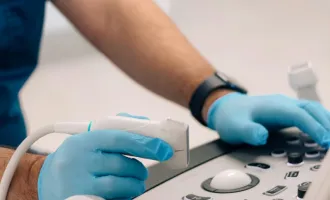This Date in UCSF: A Black Woman Professor’s Experiences
Originally published on February 12, 1981. Dr. Rosa Armstrong is not what might be considered the typical anatomist. As a Black woman, the Assistant Professor of Anatomy in Residence feels she has faced, and still confronts, the racism and sexism that pervades most U.S. institutions including UCSF.
Dr. Armstrong was born and raised in rural Louisiana, and is a graduate of Southern University, an all-Black college. In a recent interview, she recalled that, because of the inspiration of her college comparative anatomy professor, she decided to apply for the master’s degree program in anatomy at UC Berkeley.
This was a unique experience for a Black woman from a small southern Black college in the 1950’s because.
Dr. Armstrong related, “this took place before it was ‘in vogue’ to accept minorities into graduate programs, and the concept of affirmative action had not yet been defined.”
Upon completion of the master’s degree, Dr. Armstrong continued in the Department of Anatomy’s Ph.D. program.
After taking time out to work and get married, she finished her degree, then took another year off to have a baby, after which she entered a two year postdoctoral program at Stanford.
After her two years at Stanford, Dr. Armstrong decided to return to San Francisco and was hired as a lecturer in anatomy at UCSF.
“I never got tired of teaching,” she said, “but I didn’t know then what the effects of being a lecturer would have on my long-term career development.
“A lot of women are hired by the UC system to be lecturers, as I was, with no real knowledge of the conditions of their employment,” said Dr. Armstrong.
“The position has no security, you can only remain in it for a certain number of years and it offers few opportunities for advancement in the UC system.
“As a lecturer, it is exceedingly difficult to transfer to other employment tracks, such as the tenure track or even the in-residence track.
“This is mainly because you don’t compete well for grant funds which allow one to become established as an independent investigator.”
After six years as a lecturer, Dr. Armstrong was offered a position as an Assistant Professor in Residence, a nontenure track position.
But she was still assigned the same fulltime teaching load. In spite of this, she was expected to apply for and obtain enough independent grant monies to provide for her salary and generate adequate research to retain her position on the UCSF faculty.
Considering this to be an impossible situation, Dr. Armstrong approached the new anatomy department chairperson, Dr. H. J. Ralston, with the dilemma.
Dr. Ralston gave her a one-year leave from core teaching so she could begin preliminary work on a project and apply for funding.
Research
“I pursued the idea that the development of cancer and the development of the embryo might share certain biological principles,” said Dr. Armstrong.
“I decided to investigate the possible role that tissue interactions might play in the genesis and progression of human breast cancer.”
By building on this hypothesis, Dr. Armstrong wrote one grant proposal after another, submitting five grants in one-and-a-half years’ time.
Two were funded, including one by the National Institute of Health.
“Since that time,” Dr. Armstrong stated, “I have continued working on these ideas to a certain extent, but the days of scientists being able to do research in their laboratories all by themselves are gone.
“Now it is very difficult to be productive in research while operating in a vacuum; you need a team of collaborators to make substantial progress.”
Dr. Armstrong has been frustrated in her attempts to get such collaboration for her own work.
“If you’re not well established in your field, people are reluctant to even listen to your ideas,” she explained.
In Dr. Armstrong’s case, however, there is more than just “academic snobbery” involved.
“Definitely, part of it is because I am a Black woman,” she stated. “I have not had access to the support systems available to many of my colleagues at UCSF.”
For this reason, women and minorities must often work harder to achieve the same recognition as white males.
“To be sure, we are the subjects of particular scrutiny and are constantly being put in the position of authenticating ourselves and proving our credibility, said Dr. Armstrong.
“Personally, I have found that people doubt that I did the work to get my degree or came up with the ideas to successfully compete for grant funds.
“I’ve been told that I’m merely a ‘double statistic,’ and one colleague even said that I should feel fortunate that I’m here at UCSF under any circumstances.”
Dr. Armstrong has learned a lot about the academic system because of her experiences.
In her opinion, the most valuable direction for anyone aspiring to a career at a university is to “find a mentor, someone to show you the ropes, preferably someone strong in research, because that’s what determines how successful you are in climbing the academic ladder.”
“Unfortunately, teaching plays only a minor role,” Dr. Armstrong stated. “Generally, in your early years you should shun teaching and establish as many collaborative research efforts as possible.
“Such efforts generate publications, which are the key to success in academia. Efforts by the establishment to overload you with teaching, leaving little time for research, should be resisted, or you will very likely be well on your way to becoming a second-class citizen in the University.”
Dr. Armstrong stated that she has kept her balance throughout all the ups and downs at UCSF by being involved in many diverse activities.
“Have a hobby, like gardening, or anything that can invoke feelings of self-worth and accomplishment, in addition to your career goals” she urges students and faculty. “Then, when experiments are not working, you can go home to
blooming plants that you have cultivated and. still feel a sense of satisfaction.”
The encouragement and support of one’s family and friends are vital, too, especially for women who want to combine a career and family.
“Your husband must be secure enough to accept your career without feeling threatened,” Dr. Armstrong said.
“If this is the case, he will not mind helping with household chores and taking care of the kids while you attend meetings, and so on. This is a problem for a lot of women. They have enough hassles in the workplace; they don’t need to deal with more of the same at home.”
Faculty and students Dr. Armstrong believes that women faculty and students can help each other a lot.
“In the past couple of years,” she said, “some of the women faculty members have begun to organize and meet to discuss ‘in house’ as well as national problems, and this unity goes across clinical and basic science disciplines.”
Dr. D, Bainton, Dr Marilyn Harper and Dr. Marion Nestle, she said, deserve a lot of credit for helping to establish this group.
“These efforts are positive, hopeful signs that things are getting better, but there is still a certain degree of competition, jealousy and lack of support among the women at UCSF,” she said.
“This environment breeds that type of behavior.”
Dr. Armstrong added that she is happy to see women medical students also becoming more organized and supportive of each other.
However, Dr. Armstrong is in somewhat of a quandary regarding her future employment.
She considers the chances for any prospective collaboration with other researchers in her area to be slim, and feels that, instead of continuing to face the increasing difficulties of obtaining grant monies as an isolated researcher, she should try to
capitalize on what she does best.
“I enjoy teaching,” she states. “I think the University should give it more recognition.”
Ideally, Dr. Armstrong would be interested in remaining at UCSF teaching histology and gross anatomy, and working with community groups to attract young people, especially multicultural students, to pursue science careers in the university system.
“I feel strongly that we have to begin positive reinforcement of minority and female children as early as junior high school,” she said.
“We have to start letting them know that careers in science and medicine are viable options in spite of the obstacles.”
She added, though, “I’m not familiar enough with the UC administrative system to discern how funding for such projects, at a viable level, could be arranged.”
In Dr. Armstrong’s opinion, she has gained personally over her 14 years at UCSF, even if, in the University’s eyes, she has made little progress up the academic ladder.
Dr. Armstrong acknowledges that if she’d “been more aggressive and gung-ho, perhaps, and been willing to work 20 hours a day doing research and teaching,” she might have succeeded according to university standards in spite of the obstacles she had to face.
“But, I don’t regret not having done that,” she declared.
“I’m glad I had time for my family, for meaningful community involvement and to actively pursue my interest in teaching. I’ve learned a lot that I can share with people, and I have continued to grow during my years at the university.”
“I shall continue to encourage people to enter academic professions,” Dr. Armstrong added, “and give willingly of my time for the sharing of any information which might help others avoid some of the pitfalls I have encountered.”



